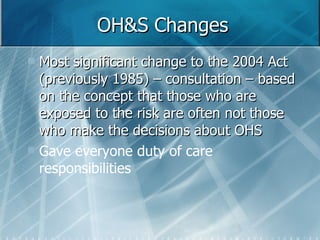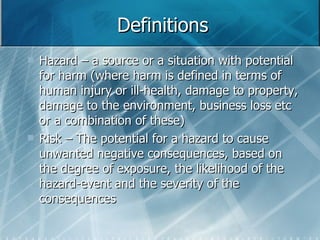O H& S Presentation
- 1. OH&S Legislation Occupational Health & Safety Act (2004) - Victoria Common Law – duty of care (places into a legal form a moral duty to anticipate possible causes of injury and illness and to do everything reasonably practicable to remove or minimise these possible causes of harm) Includes shared responsibilities for ensuring the health and safety of a learner in a learning and/or assessment environment
- 2. OH&S Changes Most significant change to the 2004 Act (previously 1985) – consultation – based on the concept that those who are exposed to the risk are often not those who make the decisions about OHS Gave everyone duty of care responsibilities
- 3. OHS legislative & common law framework OHS Act – each state or territory has its own Act governing how occupational health and safety is to be addressed Regulations – each state or territory has a range of OHS regulations that provide more specific rules that MUST be followed for a range of OHS issues or hazards Codes of Practice – developed in all states and territories and provide information on how to comply with the rules set out in Regulations – codes of practice are not rules, but should be followed
- 4. OHS legislative & common law framework cont… Australian Standards and recognised industry standards – have less authority than codes of practice - guidance tools, benchmarks, recommended minimum industry standards Guidance material – produced by a range of government and other bodies including the Australian Safety and Compensation Council (ASCC) – formally National Occupational Health & Safety Commission (NOHSC)
- 5. Acts & Regulations The Act The Occupational Health and Safety Act 2004 (the Act) is the cornerstone of legislative and administrative measures to improve occupational health and safety in Victoria. The Act sets out the key principles, duties and rights in relation to occupational health and safety. The general nature of the duties imposed by the Act means that they cover a very wide variety of circumstances, do not readily date and provide considerable flexibility for a duty holder to determine what needs to be done to comply. The Regulations The Occupational Health and Safety Regulations 2007 are made under the Act. They specify the ways duties imposed by the Act must be performed, or prescribe procedural or administrative matters to support the Act, such as requiring licenses for specific activities, keeping records, or notifying certain matters.
- 6. A learning environment might be: A work placement – where you are responsible for the learner but may not have direct control over their environment An external organisation – where you may be contracted to conduct training or assessment in their learning environment A more traditional classroom setting – where you train and assess learning in a training and assessment organisation A workplace setting – where trainers or apprentices train on site A community house – where learners are taught English language skills
- 7. OHS shared responsibility Depending upon the situation people involved might include: Managers, coordinators or supervisors Director/s of the training &/or assessment organisation Employers Health & safety advisors Human resources personnel Trainers Trainees/Employees
- 8. Duty of Care Duty of care applies wherever there is a special relationship Employer-employee RTO-client Facilitator-client Duty of care applies to all circumstances in a relationship Individual duty of care cannot be delegated, but roles and functions may be delegated Duty of care applies personally to individuals It applies to all risks that are foreseeable and preventable It includes the concept of ‘reasonable’
- 9. You should reasonably be expected to: Visit the learning environment/workplace Know about and understand the work and OHS processes in place In consultation, identify any areas for improvement that need to be addressed for a safe learning environment Check that the agreed action has been taken and develop an agreed action plan Follow up on action
- 10. Considerations Is there a documented OHS policy? Are OHS procedures and operating procedures documented? What are the processes for reporting hazards and incidents? Are these reports investigated and control measures implemented as a result of the report? What information or induction will be provided to the learner? How will the learner be supervised? Who will supervise? Are emergency procedures documented in the workplace?
- 11. Definitions Hazard – a source or a situation with potential for harm (where harm is defined in terms of human injury or ill-health, damage to property, damage to the environment, business loss etc or a combination of these) Risk – The potential for a hazard to cause unwanted negative consequences, based on the degree of exposure, the likelihood of the hazard-event and the severity of the consequences
- 12. Definitions cont… Hazard event – the interaction of a person with a hazard that could start an accident sequence Accident sequence – the sequence of events that begins with a person interacting with a hazard, a subsequent loss of control, and ends with the consequences of an accident
- 14. Hazards Physical Chemical Biological Ergonomic Psycho-social
- 15. Identify Hazards Workers compensation claims Industry reports ASCC OHS regulators Injury and incident reports Workplace reports including minutes of meetings, audit reports People in the workplace Workplace inspections Specialist advisors
- 16. Assess Risks Risk is the chance of something occurring that will result in injury or damage and the likelihood of occurrence Measured in terms “ Likelihood” or “Probability” “ Severity” or “Consequences” Exposure Prioritise hazards Different tools and methods are available (i.e. Risk Score Calculator)
- 17. Control risks Treat the risks (identify, evaluate and select treatment options) Risk control plan
- 19. Control Hierarchy cont… Design – design the plant or work process to eliminate the hazards and/or include control measures Eliminate – modify the process method or material to eliminate the hazard completely Substitute – replace the material, substance or process with a less hazardous one Redesign – redesign or modify the plant or work process to reduce or eliminate the risk
- 20. Control Hierarchy cont… Separate – isolate the hazard from persons by safeguarding or by space or time Administrate – adjust the time or conditions or the process by training, procedures, etc Personal Protective Equipment – use appropriately designed and properly fitting equipment where other controls are not practicable
- 21. Implementing controls May mean Sharing tasks Delegating some simple actions to others Involving learners Enlisting the help of internal & external expertise
- 22. Providing OHS information to learners: Some approaches might include Existing induction processes Tailored induction processes Policy and procedures manuals Quizzes or games Open discussion Debriefing – if an accident or injury does occur
- 23. Ongoing responsibility Monitor Evaluate Continuous improvement processes






















